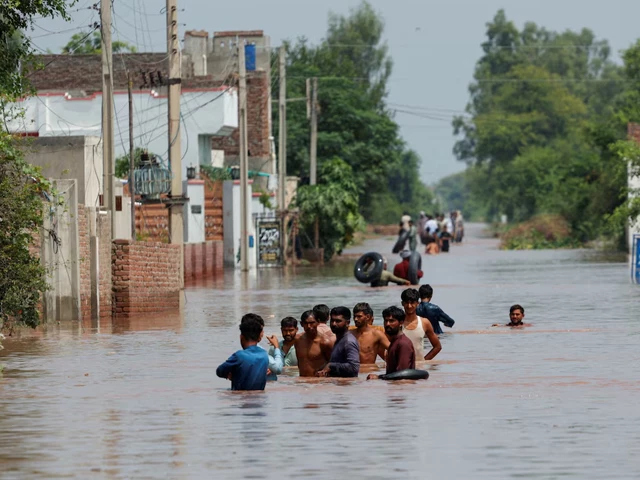Punjab is grappling with the worst flooding in its history, with death toll rises to 41 while more than 2.4 million people affected and thousands of villages inundated, according to the Provincial Disaster Management Authority (PDMA).
DG PDMA Irfan Ali Kathia told reporters on Monday that heavy monsoon rains and rising river levels have inundated at least 3,100 villages and nearly 2,900 hamlets across the province.
He said rescue agencies are conducting the largest operation in history, with more than 900,000 residents have so far been evacuated to safer locations. Floodwaters have also forced the shifting of over 600,000 livestock. The provincial livestock department has provided feed and shelter for the animals. Authorities have established 390 relief camps to house displaced families.
Kathia mentioned that no new surge has entered Pakistan from India through Head Marala, although heavy rainfall continues to push water levels higher in various tributaries. At Nullah Leh in Rawalpindi, flood levels reached 19 feet at Katarian Bridge following fresh downpours.
Authorities briefed the chief minister at Head Trimmu, mentioning that controlled breaches have been carried out in some areas — including Rewas Bridge — to lessen the pressure on flood-hit districts including Jhang.
It is expected that water from the Chenab will reach Multan on Tuesday, combining with inflows from the Ravi. At Sadhnai, a major flood surge could require a breach near Safora overnight, potentially affecting 14 villages and 17,000 acres of land.
Similarly, Head Muhammadwala could see flows of up to 650,000 cusecs, with officials warning that as many as 16 villages may be impacted if breaching becomes necessary.
Looking ahead, PDMA estimates that flows at Panjnad are now expected to peak on Septembert 5, though at lower levels than earlier forecast. Water from the Sutlej continues to move towards Suleimanki and Head Islam.
“Rescue teams are working tirelessly, and despite the widespread damage, timely measures have prevented higher casualties,” Kathia said.
For now, officials say they are bracing for two more days of monsoon rain across the province, which could complicate relief efforts and add to the swelling rivers.
Punjab Senior Minister Maryam Aurangzeb sounded the alarm as unprecedented flooding in the Chenab, Jhelum, and Ravi rivers threatened 11 districts, including Jhang, Sahiwal, Toba Tek Singh, Okara, Multan, Pakpattan, Bahawalnagar, Vehari, and Bahawalpur.
By late tonight, the Chenab River is expected to witness its largest historic flood of 900,000 cusecs. Additionally, floodwaters from the Ravi River are expected to merge into the Chenab tonight.
Severe flooding is reported at Trimmu, Balloki, Sulemanki, and Ganda Singh Wala, while medium-level flooding affects Khanki, Qadirabad, and Shahdara.
Water levels in the Chenab River have begun rising at Head Muhammad Wala, with the flow now surpassing 200,000 cusecs. Over the next 24 hours, a flood surge of 480,000 cusecs is expected to hit Head Muhammad. At Head Trimmu, water discharge has reached up to 550,000 cusecs.
In Rajanpur, the protective embankment of Samti village broke due to the flood surge, and water has rapidly inundated nearby villages and fish farms. The floodwaters coming from Jhang have begun engulfing all settlements in the Jawana Bangla area of Muzaffargarh. Currently, a flood flow of 400,000 cusecs is passing between Jhang and Muzaffargarh in the Chenab River.
The Sutlej River continues to wreak havoc in Bahawalpur, with riverbank erosion intensifying. Floodwaters have begun to engulf nearby areas, including Mari Qasim Shah, leaving residents stranded. A major flood is expected to pass through the city in the next two days.
The Pakistan Meteorological Department (PMD) issued a warning on Monday morning regarding upcoming rainfall. According to PMD, “widespread heavy to very-heavy rainfall, along with torrential downpours at scattered places, is expected over the upper catchments of Rivers Sutlej, Beas, Ravi, and Chenab, as well as in Lahore and Gujranwala divisions, during September 1 and 3.”
PMD also warned of exceptionally high floods expected in the Chenab, Sutlej, and Ravi rivers due to releases from Indian reservoirs. Urban flooding is also expected in Lahore, Gujranwala, and Gujrat divisions over the next 72 hours.
Relief Efforts
Rescue and relief operations by the Pakistan Army are ongoing in Okara, Sahiwal, Multan, and other affected areas. In Sahiwal, 24 relief camps have been established across 37 villages, while army and civil administration teams have relocated 9,797 people and 2,191 livestock to safe locations.
Medical camps have been set up at Attari and Suleimanki Head, and essential supplies, including wheat, have been delivered. In Okara, 487 people and 218 livestock have been moved, and in Sahiwal, 3,162 people and 4,593 livestock have been relocated.
In Multan, the flood relief camp in Basti Langrial has left residents struggling in extreme heat, with many reporting that tents promised days ago have yet to be provided. Victims also claim they were forcibly evicted from their homes.
The floods in Punjab have claimed 35 lives, affected over 2.3 million people, and impacted 2,222 villages. So far, 857,824 people have been relocated, with 383 relief camps and 375 medical centers operational.
Livestock relocation includes 551,769 animals, supported by 329 veterinary medical facilities.

